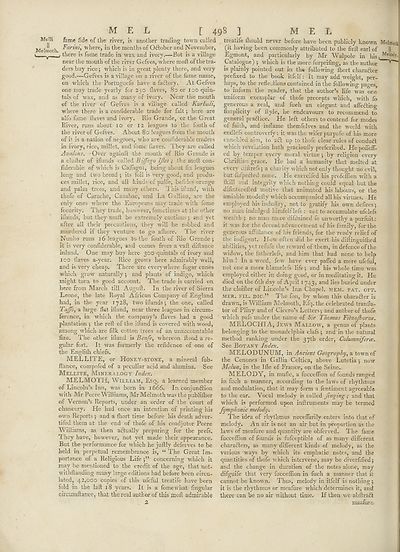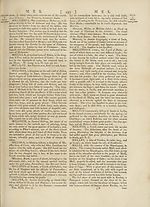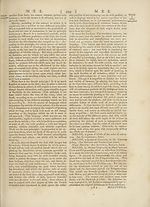Encyclopaedia Britannica, or, a Dictionary of arts, sciences, and miscellaneous literature : enlarged and improved. Illustrated with nearly six hundred engravings > Volume 13, MAT-MIC
(540) Page 498
Download files
Complete book:
Individual page:
Thumbnail gallery: Grid view | List view

M E L
MclH
Melmoth.
[ 49S ]
MEL
fame fide of the river, is another trading town called
Farini, where, in the months of October and November,
there is fome trade in wax and ivory.—Bot is a village
near the mouth of the river Gefves, where moft of the tra¬
ders buy rice; which is in great plenty there, and very
good.—Gefves is a village on a river of the fame name,
on which the Portuguefe have a factory. At Gefves
one may trade yearly for 250 Haves, 80 or 100 quin¬
tals of wax, and as many of ivory. Near the mouth
of the river of Gefves is a village called Kurbuh,
where there is a confiderable trade for fait ; here are
alfo fume Haves and ivory. Rio Grande, or the Great
River, runs about 10 or 12 leagues to the fouth of
the river of Gefves. About 80 leagues from the mouth
of it is a-nation of negroes, who are confiderable traders
in ivory, rice-, millet, and fome Haves. They are called
Auctions. Over a gain ft the mouth of Rio Grande is
a duller of ifiands called Bi/Jago IJles ; the moft con-
liderable of which is Caffaguc, being about fix leagues
long and two broad j its foil is very good, and produ¬
ces millet, rice, and all kinds of pulfe, befides orange
and palm trees, and many others. This ifland, with
thofe of Carache, Canabac, and La Gallina, are the
only ones where the Europeans may trade with fome
fecurity. They trade, howrever, fometimes at the other
ifiands, but they mult be extremely cautious 5 and yet
after all their precautions, they will be robbed and
murdered if they venture to go afhore. The river
Nunho runs 16 leagues to the fouth of Rio Grande j
it is very confiderable, and comes from a vaft diftance
inland. One may buy here 300 quintals of ivory and
ico Haves a-year. Rice grows here admirably well,
and is very cheap. There are everywhere fugar canes
which grow naturally; and plants of indigo, which
might turn to good account. The trade is carried on
here from March till Auguft. In the river of Sierra
Leone, the late Royal African Company of England
had, in the year 1728, two ifiands; the one, called
TaJpj, a large Hat ifland, near three leagues in circum¬
ference, in which the company^ Haves had a good
plantation ; the reft of the ifland is covered with wood,
among which are filk cotton trees of an unaccountable
fize. The other ifland is Benfe, whereon flood a re¬
gular fort. It was formerly the refidence of one of
the Englifli chiefs.
MEL LITE, or Honey-stone, a mineral fub-
ftance, compofed of a peculiar acid and alumina. See
Mellite, Mineralogy Index.
MELMOTH, William, Esq. a learned member
of Lincoln’s Inn, was born in 1666. In conjunftion
with Mr Peere Williams, Mr Melmoth was the publifher
of Vernon’s Reports, under an order of the court of
chancery. He had once an intention of printing his
own Reports; and a fliort time before his death adver-
tifed them at the end of thole of his coadjutor Peere
Will lams, as then actually preparing for the prefs.
They have, however, not yet made their appearance.
But the performance for which he juftly defei ves to be
held in perpetual remembrance is, “ The Great Im¬
portance of a Religious Life 5” concerning which it
may be mentioned to the credit of the age, that not-
withftanding many large editions had before been circu¬
lated, 42,000 copies of this ufeful treatife have been
fold in the laft 18 years. It is a fomewhat Angular
circumftance, that the real author of this moft admirable
2
treatife fliould never before have been publicly known
(it having been commonly attributed to the firft earl of
Egmont, and particularly by Mr Walpole in his,
Catalogue) ; which is the more furprifing, as the author
is plainly pointed out in the following Ihort charadler
prefixed to the book itfelf: It may add weight, per¬
haps, to the refle ftions contained in the following pages,
to inform the reader, that the author’s life was one
uniform exemplar of thofe precepts which, with fo
generous a zeal, and fueh an elegant and affe&ing
fimplicity of ityle, he endeavours to recommend to
general praftice. He left others to contend for modes
of faith, and inflame themfelves and the world with
endlefs controverfy : it was the wifer purpofe of his more
ennobled aim, to a£l up to thofe clear rules of conduft
which revelation hath gracioufly preferibed. He poffeff-
cd by temper every moral virtue j by religion every
Chriftian grace. He had a humanity that melted at
every diftrefs; a charity which not only thought no evil-,
but i’ufpeCled none. He exercifed his profeflion with a
Hull and integrity which nothing could equal but the
difinterefted motive that animated his labours, or the
amiable modefty which accompanied all his virtues. He
employed his induftry, not to gratify his own defires;
no man indulged himfelf lefs : not to accumulate ufelefs
wealth ; no man more difdained fo unworthy a purfuit:
it was for the decent advancement of his family, for the
generous afliftance of his friends, for the ready relief of
the indigent. How often did he exert his diftinguiflied
abilities, yet refufe the reward of them, in defence of the
widow, the fathcrlefs, and him that had none to help
him ! In a word, few have ever palled a more ufeful,
not one a more blamelefs life; and his whole time was
employed either in doing good, or in meditating it. He
died on the 6th day of April 1743, and lies buried under
the cloifter of Lincoln’s Inn Chapel, mem. pat. opt.
mer. fil. Die.” The fon, by whom this character is
drawn, is William Melmoth, Efq. the celebrated tranfla-
tor of Pliny and of Cicero’s Letters; and author of thofe
which pafs under the name of Sir Thomas Fitz-rjborne.
MELOCHIA, Jews Mall ow, a genus of plants
belonging to the monadelphia clafs ; and in the natural
method ranking under the 37th order, Columniferce.
See Botany Index.
MELODUNUM, in Ancient Geography, a town of
the Cenones in Gallia Celtica, above Lutetia ; now
Me/un, in the Ifle of France, on the Seine.
MELODY, in mufic, a fucceflion of founds ranged
in fuch a manner, according to the laws of rhythmus
and modulation, that it may form a fentiment agreeable
to the ear. Vocal melody is called finging ; and that
which is performed upon inflruments may be termed
fymphonic melody.
The idea of rhythmus neceflaril'y enters into that of
melody. An air is not an air but in proportion as the
laws of meafure and quantity are obferved. The fame
fucceffion of founds is fufceptible of as many different
charadlers, as many different kinds of melody, as the
various ways by which its emphatic notes, and the
quantities of thofe which intervene, may be diverfified;
and the change in duration of the notes alone, may
difguife that very fucceffion in fuch a manner that it
cannot be known. Thus, melody in itfelf is nothing;
it is the rhythmus or meafure which determines it, and
there can be no air without time. If then we abftracl
msafure-
Melmoti
II
M elody,
MclH
Melmoth.
[ 49S ]
MEL
fame fide of the river, is another trading town called
Farini, where, in the months of October and November,
there is fome trade in wax and ivory.—Bot is a village
near the mouth of the river Gefves, where moft of the tra¬
ders buy rice; which is in great plenty there, and very
good.—Gefves is a village on a river of the fame name,
on which the Portuguefe have a factory. At Gefves
one may trade yearly for 250 Haves, 80 or 100 quin¬
tals of wax, and as many of ivory. Near the mouth
of the river of Gefves is a village called Kurbuh,
where there is a confiderable trade for fait ; here are
alfo fume Haves and ivory. Rio Grande, or the Great
River, runs about 10 or 12 leagues to the fouth of
the river of Gefves. About 80 leagues from the mouth
of it is a-nation of negroes, who are confiderable traders
in ivory, rice-, millet, and fome Haves. They are called
Auctions. Over a gain ft the mouth of Rio Grande is
a duller of ifiands called Bi/Jago IJles ; the moft con-
liderable of which is Caffaguc, being about fix leagues
long and two broad j its foil is very good, and produ¬
ces millet, rice, and all kinds of pulfe, befides orange
and palm trees, and many others. This ifland, with
thofe of Carache, Canabac, and La Gallina, are the
only ones where the Europeans may trade with fome
fecurity. They trade, howrever, fometimes at the other
ifiands, but they mult be extremely cautious 5 and yet
after all their precautions, they will be robbed and
murdered if they venture to go afhore. The river
Nunho runs 16 leagues to the fouth of Rio Grande j
it is very confiderable, and comes from a vaft diftance
inland. One may buy here 300 quintals of ivory and
ico Haves a-year. Rice grows here admirably well,
and is very cheap. There are everywhere fugar canes
which grow naturally; and plants of indigo, which
might turn to good account. The trade is carried on
here from March till Auguft. In the river of Sierra
Leone, the late Royal African Company of England
had, in the year 1728, two ifiands; the one, called
TaJpj, a large Hat ifland, near three leagues in circum¬
ference, in which the company^ Haves had a good
plantation ; the reft of the ifland is covered with wood,
among which are filk cotton trees of an unaccountable
fize. The other ifland is Benfe, whereon flood a re¬
gular fort. It was formerly the refidence of one of
the Englifli chiefs.
MEL LITE, or Honey-stone, a mineral fub-
ftance, compofed of a peculiar acid and alumina. See
Mellite, Mineralogy Index.
MELMOTH, William, Esq. a learned member
of Lincoln’s Inn, was born in 1666. In conjunftion
with Mr Peere Williams, Mr Melmoth was the publifher
of Vernon’s Reports, under an order of the court of
chancery. He had once an intention of printing his
own Reports; and a fliort time before his death adver-
tifed them at the end of thole of his coadjutor Peere
Will lams, as then actually preparing for the prefs.
They have, however, not yet made their appearance.
But the performance for which he juftly defei ves to be
held in perpetual remembrance is, “ The Great Im¬
portance of a Religious Life 5” concerning which it
may be mentioned to the credit of the age, that not-
withftanding many large editions had before been circu¬
lated, 42,000 copies of this ufeful treatife have been
fold in the laft 18 years. It is a fomewhat Angular
circumftance, that the real author of this moft admirable
2
treatife fliould never before have been publicly known
(it having been commonly attributed to the firft earl of
Egmont, and particularly by Mr Walpole in his,
Catalogue) ; which is the more furprifing, as the author
is plainly pointed out in the following Ihort charadler
prefixed to the book itfelf: It may add weight, per¬
haps, to the refle ftions contained in the following pages,
to inform the reader, that the author’s life was one
uniform exemplar of thofe precepts which, with fo
generous a zeal, and fueh an elegant and affe&ing
fimplicity of ityle, he endeavours to recommend to
general praftice. He left others to contend for modes
of faith, and inflame themfelves and the world with
endlefs controverfy : it was the wifer purpofe of his more
ennobled aim, to a£l up to thofe clear rules of conduft
which revelation hath gracioufly preferibed. He poffeff-
cd by temper every moral virtue j by religion every
Chriftian grace. He had a humanity that melted at
every diftrefs; a charity which not only thought no evil-,
but i’ufpeCled none. He exercifed his profeflion with a
Hull and integrity which nothing could equal but the
difinterefted motive that animated his labours, or the
amiable modefty which accompanied all his virtues. He
employed his induftry, not to gratify his own defires;
no man indulged himfelf lefs : not to accumulate ufelefs
wealth ; no man more difdained fo unworthy a purfuit:
it was for the decent advancement of his family, for the
generous afliftance of his friends, for the ready relief of
the indigent. How often did he exert his diftinguiflied
abilities, yet refufe the reward of them, in defence of the
widow, the fathcrlefs, and him that had none to help
him ! In a word, few have ever palled a more ufeful,
not one a more blamelefs life; and his whole time was
employed either in doing good, or in meditating it. He
died on the 6th day of April 1743, and lies buried under
the cloifter of Lincoln’s Inn Chapel, mem. pat. opt.
mer. fil. Die.” The fon, by whom this character is
drawn, is William Melmoth, Efq. the celebrated tranfla-
tor of Pliny and of Cicero’s Letters; and author of thofe
which pafs under the name of Sir Thomas Fitz-rjborne.
MELOCHIA, Jews Mall ow, a genus of plants
belonging to the monadelphia clafs ; and in the natural
method ranking under the 37th order, Columniferce.
See Botany Index.
MELODUNUM, in Ancient Geography, a town of
the Cenones in Gallia Celtica, above Lutetia ; now
Me/un, in the Ifle of France, on the Seine.
MELODY, in mufic, a fucceflion of founds ranged
in fuch a manner, according to the laws of rhythmus
and modulation, that it may form a fentiment agreeable
to the ear. Vocal melody is called finging ; and that
which is performed upon inflruments may be termed
fymphonic melody.
The idea of rhythmus neceflaril'y enters into that of
melody. An air is not an air but in proportion as the
laws of meafure and quantity are obferved. The fame
fucceffion of founds is fufceptible of as many different
charadlers, as many different kinds of melody, as the
various ways by which its emphatic notes, and the
quantities of thofe which intervene, may be diverfified;
and the change in duration of the notes alone, may
difguife that very fucceffion in fuch a manner that it
cannot be known. Thus, melody in itfelf is nothing;
it is the rhythmus or meafure which determines it, and
there can be no air without time. If then we abftracl
msafure-
Melmoti
II
M elody,
Set display mode to:
![]() Universal Viewer |
Universal Viewer | ![]() Mirador |
Large image | Transcription
Mirador |
Large image | Transcription
Images and transcriptions on this page, including medium image downloads, may be used under the Creative Commons Attribution 4.0 International Licence unless otherwise stated. ![]()
| Permanent URL | https://digital.nls.uk/192668182 |
|---|
| Attribution and copyright: |
|
|---|
| Description | Ten editions of 'Encyclopaedia Britannica', issued from 1768-1903, in 231 volumes. Originally issued in 100 weekly parts (3 volumes) between 1768 and 1771 by publishers: Colin Macfarquhar and Andrew Bell (Edinburgh); editor: William Smellie: engraver: Andrew Bell. Expanded editions in the 19th century featured more volumes and contributions from leading experts in their fields. Managed and published in Edinburgh up to the 9th edition (25 volumes, from 1875-1889); the 10th edition (1902-1903) re-issued the 9th edition, with 11 supplementary volumes. |
|---|---|
| Additional NLS resources: |
|

